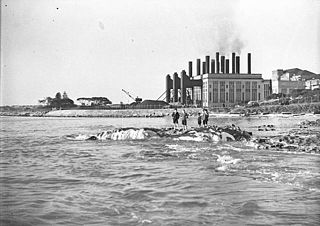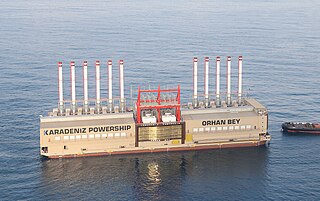An energy crisis or energy shortage is any significant bottleneck in the supply of energy resources to an economy. In literature, it often refers to one of the energy sources used at a certain time and place, in particular, those that supply national electricity grids or those used as fuel in industrial development. Population growth has led to a surge in the global demand for energy in recent years. In the 2000s, this new demand – together with Middle East tension, the falling value of the US dollar, dwindling oil reserves, concerns over peak oil, and oil price speculation – triggered the 2000s energy crisis, which saw the price of oil reach an all-time high of $147.30 per barrel ($926/m3) in 2008.

Emanuel Shinwell, Baron Shinwell, was a British politician who served as a government minister under Ramsay MacDonald and Clement Attlee. A member of the Labour Party, he served as a Member of Parliament (MP) for 40 years, representing Linlithgowshire, Seaham and Easington.

HMS Tireless was the third Trafalgar-class nuclear submarine of the Royal Navy. Tireless is the second submarine of the Royal Navy to bear this name. Launched in March 1984, Tireless was sponsored by Sue Squires, wife of Admiral 'Tubby' Squires, and commissioned in October 1985.
India is the third largest producer of electricity in the world. During the fiscal year (FY) 2023–24, the total electricity generation in the country was 1,949 TWh, of which 1,734 TWh was generated by utilities.

Royal Navy Dockyards were state-owned harbour facilities where ships of the Royal Navy were built, based, repaired and refitted. Until the mid-19th century the Royal Dockyards were the largest industrial complexes in Britain.
Air-independent propulsion (AIP), or air-independent power, is any marine propulsion technology that allows a non-nuclear submarine to operate without access to atmospheric oxygen. AIP can augment or replace the diesel-electric propulsion system of non-nuclear vessels.

Peaking power plants, also known as peaker plants, and occasionally just "peakers", are power plants that generally run only when there is a high demand, known as peak demand, for electricity. Because they supply power only occasionally, the power supplied commands a much higher price per kilowatt hour than base load power. Peak load power plants are dispatched in combination with base load power plants, which supply a dependable and consistent amount of electricity, to meet the minimum demand.

A diesel generator (DG) (also known as a diesel GenSet) is the combination of a diesel engine with an electric generator (often an alternator) to generate electrical energy. This is a specific case of an engine generator. A diesel compression-ignition engine is usually designed to run on diesel fuel, but some types are adapted for other liquid fuels or natural gas (CNG).
Vegetable oil can be used as an alternative fuel in diesel engines and in heating oil burners. When vegetable oil is used directly as a fuel, in either modified or unmodified equipment, it is referred to as straight vegetable oil (SVO) or pure plant oil (PPO). Conventional diesel engines can be modified to help ensure that the viscosity of the vegetable oil is low enough to allow proper atomization of the fuel. This prevents incomplete combustion, which would damage the engine by causing a build-up of carbon. Straight vegetable oil can also be blended with conventional diesel or processed into biodiesel, HVO or bioliquids for use under a wider range of conditions.
The energy policy of India is to increase the locally produced energy in India and reduce energy poverty, with more focus on developing alternative sources of energy, particularly nuclear, solar and wind energy. Net energy import dependency was 40.9% in 2021-22. The primary energy consumption in India grew by 13.3% in FY2022-23 and is the third biggest with 6% global share after China and USA. The total primary energy consumption from coal, crude oil, natural gas, nuclear energy, hydroelectricity and renewable power is 809.2 Mtoe in the calendar year 2018. In 2018, India's net imports are nearly 205.3 million tons of crude oil and its products, 26.3 Mtoe of LNG and 141.7 Mtoe coal totaling to 373.3 Mtoe of primary energy which is equal to 46.13% of total primary energy consumption. India is largely dependent on fossil fuel imports to meet its energy demands – by 2030, India's dependence on energy imports is expected to exceed 53% of the country's total energy consumption.

The winter of 1946–1947 was harsh in Europe, and noted for its adverse effects in the United Kingdom. It caused severe hardships in economic terms and living conditions in a country still recovering from the Second World War. There were massive disruptions of energy supply for homes, offices and factories. Animal herds froze or starved to death. People suffered from the persistent cold, and many businesses shut down temporarily. When warm weather returned, the ice thawed and flooding was severe in most low-lying areas.

Bunnerong Power Station was a coal-fired power station in the south-eastern Sydney suburb of Matraville, New South Wales, Australia that was decommissioned by 1975 and subsequently demolished. When the last generating units were commissioned, it was the largest power station in the southern hemisphere, with a capacity of 375 megawatts (MW) from eleven turbo-alternators. It was able to supply up to one third of the state's electricity needs at the time. It remained the most powerful until the completion of Vales Point Power Station in 1966.

The Western Australian gas crisis was a major disruption to natural gas supply in Western Australia, caused by the rupture of a corroded pipeline and subsequent explosion at a processing plant on Varanus Island, off the state's north west coast on 3 June 2008. The plant, operated by Apache Energy, which normally supplied a third of the state's gas, was shut down for almost two months while a detailed engineering investigation and major repairs were carried out. Gas supply from the plant partially resumed in late August. By mid-October, gas production was running at two-thirds of normal capacity, with 85% of full output restored by December 2008.
Meaford Power Station was a coal-fired power station situated on the River Trent at Meaford near Stone in Staffordshire.

A powership is a special purpose ship, on which a power plant is installed to serve as a power generation resource.

The National Grid covers most of mainland Great Britain and several of the surrounding islands, and there are interconnectors to Northern Ireland and to other European countries. Power is supplied to consumers at 230 volts AC with a frequency of 50 Hz. In 2023 about a third of electricity used in Britain was generated from fossil gas and two-thirds was low-carbon power. Wind generates the most low-carbon power, followed by nuclear some of which is imported from France. The government is aiming for greenhouse gas emissions from electricity in Britain to be net zero by 2035.

Electricity sector in Hong Kong ranges from generation, transmission, distribution and sales of electricity covering Hong Kong. The combustion of coal, natural gas and oil are the main sources of electricity in Hong Kong. The electricity sector contributes 60.4% of Hong Kong's total greenhouse gas emissions.

Sisu was a Finnish state-owned icebreaker. Built in 1939 at Wärtsilä Hietalahti Shipyard in Helsinki, she was one of the world's first diesel-electric icebreakers. In addition to icebreaking duties, she served as a submarine tender for the Finnish Navy during the summer months until the end of the Continuation War.
Ribble Power Station was a coal-fired electricity generating station on the River Ribble in Penwortham near Preston, Lancashire, England. The station was built by the Corporation of Preston to replace a small privately-run generating station in the town. It supplied electricity to Preston and the surrounding area from 1923 until 1976. The station was expanded with new equipment in 1943–47 which remained in operation until the power station was closed in 1976 and was subsequently demolished.

HMS Valerian was an Arabis-class sloop of the Royal Navy, built by Charles Rennoldson and Company, South Shields, and launched 21 February 1916. After service in the First World War, she foundered off Bermuda in the 1926 Havana–Bermuda hurricane, on 22 October 1926.













